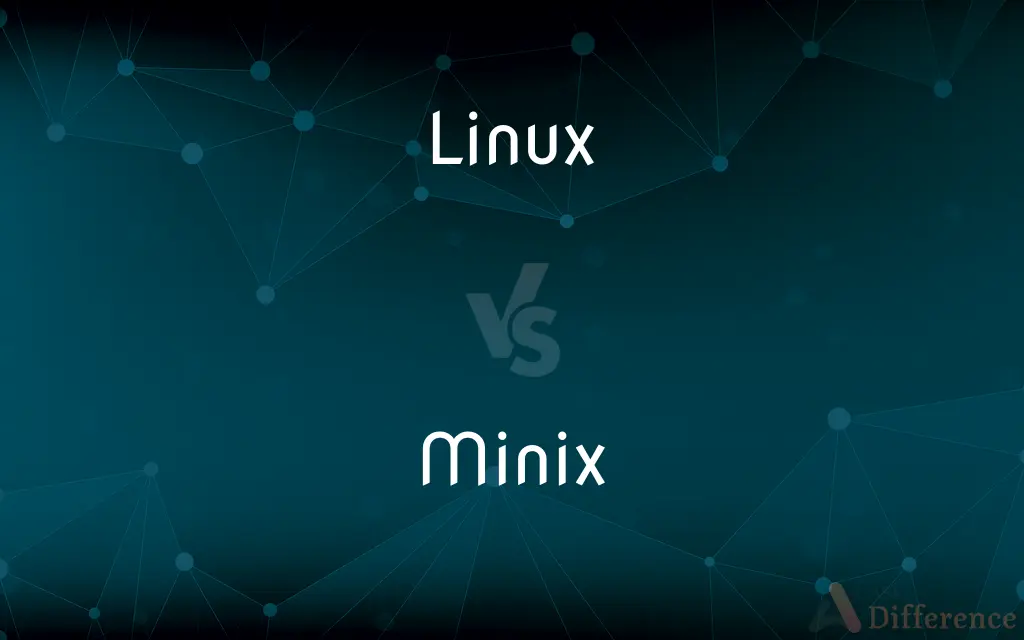Linux vs. Minix — What's the Difference?
By Maham Liaqat & Fiza Rafique — Updated on May 2, 2024
Linux is a robust, widely-used operating system kernel, ideal for various applications from servers to desktops, whereas Minix is more educational, designed to teach system programming.

Difference Between Linux and Minix
Table of Contents
ADVERTISEMENT
Key Differences
Linux is an open-source operating system kernel first released by Linus Torvalds in 1991, which has grown to support a wide range of hardware and software. Whereas, Minix, developed by Andrew S. Tanenbaum in 1987, serves primarily as a teaching tool for operating systems.
Linux is known for its robustness and efficiency in handling complex, multi-user and multi-tasking operations, suitable for both personal and professional computing. On the other hand, Minix emphasizes simplicity and clarity of design, useful for students and educators in the field of computer science.
Linux supports a wide array of device drivers and networking protocols, making it adaptable in diverse computing environments. Whereas Minix's smaller code base focuses on clean and manageable implementations for educational purposes rather than broad hardware support.
The Linux kernel is at the heart of various popular distributions like Ubuntu, Fedora, and Debian, each offering a complete operating system experience. In contrast, Minix is typically used standalone in academic settings where users can experiment with kernel modifications.
Linux benefits from the support of a massive community of developers and users, contributing to its continuous development and security. In contrast, Minix, while also open-source, has a much smaller community primarily focused on educational enhancements.
ADVERTISEMENT
Comparison Chart
Purpose
General-purpose, versatile
Educational, simple
Initial Release
1991
1987
Main Use Cases
Servers, desktops, embedded systems
Teaching, learning system programming
Community Size
Large, global
Smaller, academic
Design Focus
Robustness, scalability
Clarity, manageability
Compare with Definitions
Linux
The core part of Linux, managing system resources and hardware communication.
Linux kernel 5.8 introduced significant updates to networking and storage handling.
Minix
Primarily used for educational purposes to teach operating system concepts.
Many universities use Minix in computer science courses.
Linux
A complete operating system built around the Linux kernel, including software and graphical environment.
Ubuntu is a popular Linux distribution.
Minix
Minix is designed to be simple and portable, making it easy to understand and modify.
Minix can run on minimal and varied hardware setups.
Linux
Linux is renowned for its robust security features, making it popular for servers and sensitive applications.
Linux systems use SELinux for advanced access control.
Minix
Like Linux, Minix is open-source, providing source code access for educational use.
Students can experiment with Minix’s kernel code to learn about OS design.
Linux
Linux is developed in an open-source environment, allowing free access and modification of its source code.
Linux’s source code can be freely modified and shared.
Minix
Minix’s design is lightweight, aiming to be efficient and easy to manage in educational settings.
Minix can operate efficiently on older hardware for educational demonstrations.
Linux
A vast network of developers and users who support and develop the Linux ecosystem.
The Linux community collaborates on platforms like GitHub.
Minix
Minix uses a microkernel architecture, which handles basic system services only.
Minix’s microkernel design contributes to its stability and simplicity.
Linux
Linux ( (listen) LEEN-uuks or LIN-uuks) is a family of open-source Unix-like operating systems based on the Linux kernel, an operating system kernel first released on September 17, 1991, by Linus Torvalds. Linux is typically packaged in a Linux distribution.
Minix
Minix (from mini-Unix) is a Unix-like operating system based on a microkernel architecture. Since version 2.0, it has been Portable Operating System Interface (POSIX) compliant.Early versions of MINIX were created by Andrew S. Tanenbaum for educational purposes.
Linux
An open-source operating system modelled on UNIX.
Linux
(software) Any unix-like operating system that uses the Linux kernel.
Linux
An open-source version of the UNIX operating system
Common Curiosities
How does the community size differ between Linux and Minix?
Linux has a vast, global community of developers and users, while Minix’s community is smaller and more academically oriented.
Can Minix be used for general computing like Linux?
While possible, Minix is not typically designed for general computing but focuses on educational use.
What are the advantages of Linux’s kernel architecture over Minix?
Linux’s monolithic kernel is designed for robustness and high performance in diverse environments.
How does Minix handle device drivers compared to Linux?
Minix handles drivers in user space for safety and simplicity, whereas Linux integrates them into the kernel for performance.
Is Linux suitable for educational purposes like Minix?
Yes, Linux can also be used educationally, especially for advanced system programming and real-world applications.
What is the main purpose of Linux?
Linux is designed for general-purpose use, from personal computing to servers and embedded systems.
What distinguishes Minix as an educational tool?
Minix’s simplicity and clear design make it ideal for teaching and understanding operating system concepts.
What type of hardware compatibility does Linux offer?
Linux supports a broad range of hardware, from consumer PCs to powerful servers.
Can Linux run on minimal hardware like Minix?
Yes, Linux can be configured to run on minimal hardware, though typically it is used on more capable machines.
Which operating system is better for learning operating system architecture?
For foundational learning, Minix is often preferred due to its simpler, cleaner design, while Linux offers insight into a complex, real-world system.
How does Minix's microkernel architecture benefit its users?
The microkernel architecture makes Minix stable and simple, ideal for educational purposes and kernel experimentation.
Can you modify the source code of Minix?
Yes, Minix is open-source, and its source code can be modified, especially for educational purposes.
Which is more secure, Linux or Minix?
Linux generally has more advanced security features, tailored to its use in diverse and critical environments.
What role does the Linux community play in its development?
The Linux community plays a crucial role, contributing to everything from bug fixes to feature enhancements.
How are updates handled in Minix compared to Linux?
Minix updates focus on educational clarity and stability, while Linux updates address a broad range of improvements from security to hardware compatibility.
Share Your Discovery

Previous Comparison
Toupe vs. Toupee
Next Comparison
Similar vs. SimularAuthor Spotlight
Written by
Maham LiaqatCo-written by
Fiza RafiqueFiza Rafique is a skilled content writer at AskDifference.com, where she meticulously refines and enhances written pieces. Drawing from her vast editorial expertise, Fiza ensures clarity, accuracy, and precision in every article. Passionate about language, she continually seeks to elevate the quality of content for readers worldwide.
















































